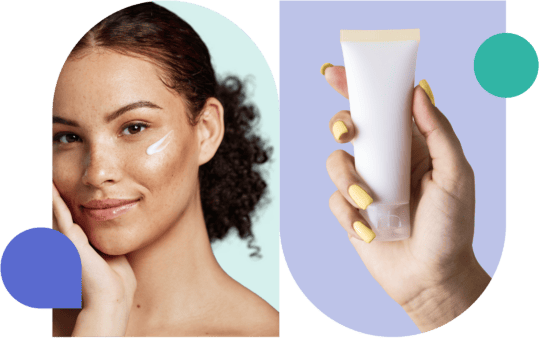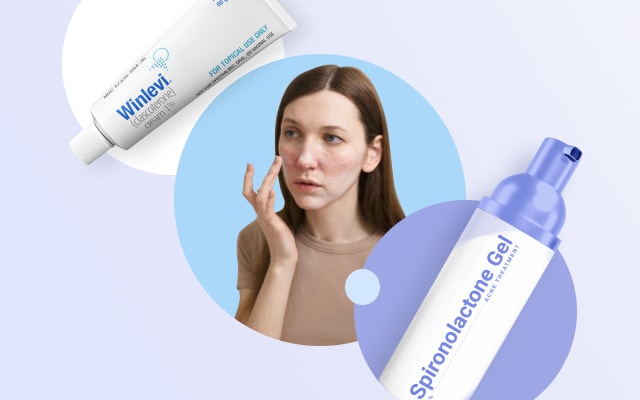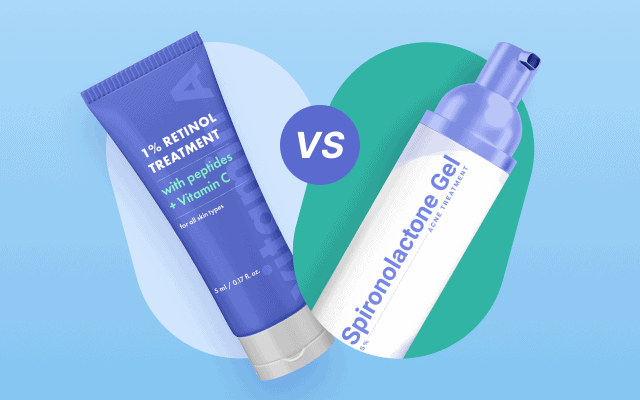The best treatments to improve textured skin according to a dermatologist
Learn more about the most popular treatments to improve skin texture according to a dermatologist and choose the option that suits your needs and budget.
Covered in this article:
Causes | How to get treatment? | Signs | Can you reverse it? | When to consult a dermatologist? | How to get rid of rough skin texture on the face? | How to get rid of rough skin texture on the body? | FAQ
Our commitment to producing high-quality content:
The information presented in this article is based on scientific research and the professional advice of our Content Medical Reviewers, who are experts in the field of Dermatology. How we write our content →
Dr. Eric Howell, board-certified dermatologist, says that skin texture refers to the surface quality and appearance of your skin. Ideally, smooth, even skin texture means the skin feels soft and has a uniform surface without noticeable imperfections like bumps, roughness, or large pores.
Uneven skin texture, on the other hand, may appear rough or bumpy and can be caused by many different things such as acne, scarring, or sun damage. Improving skin texture often involves skincare routines or treatments aimed at smoothing the skin and making it look more refined and healthy.
What causes rough or uneven skin texture?
Dr. Howell says that rough or uneven skin texture can be caused by a variety of factors, including:
- Acne and breakouts: Pimples, blackheads, and whiteheads can leave behind bumps or scars, leading to uneven texture1.
- Sun damage: Overexposure to UV rays can cause thickening of the skin, wrinkles, and uneven pigmentation, contributing to rough texture2.
- Scarring: Injuries, acne, or skin conditions like eczema can leave scars that disrupt the smoothness of the skin3.
- Dryness: Lack of moisture can cause the skin to become flaky, rough, and uneven4.
- Dead skin cell buildup: Without regular exfoliation, dead skin cells accumulate on the skin’s surface, creating a dull and uneven texture 5.
- Enlarged pores: Large pores can make the skin appear less smooth and contribute to roughness, often exacerbated by oil production6.
- Pollution and environmental factors: Dirt, debris, and pollutants can clog pores and damage the skin’s surface, leading to texture irregularities7.
- Aging: As the skin ages, it loses collagen and elasticity, which can make the skin appear rough or wrinkled8.
How can I get treatment to improve my skin texture?
The best way to get treatment to improve rough skin texture is to have a consultation with a board-certified dermatologist via Miiskin. The dermatologist will choose adequate treatment based on the condition of your skin and your symptoms. The treatment prescribed may include topical retinoids, hydroquinone, azelaic acid, vitamin C or niacinamide among other ingredients.
Signs of uneven skin texture
These symptoms are indicators of irregularities in your skin’s smoothness and can be improved with proper care and treatment.
- Rough patches: The skin feels uneven or coarse to the touch.
- Bumps: Small, raised areas like acne, blackheads, or keratosis pilaris.
- Dryness or flakiness: Peeling or flaky skin indicates texture issues caused by lack of moisture.
- Enlarged pores: Visible or pronounced pores can create an uneven appearance.
- Acne scars: Pitted or raised areas resulting from past breakouts.
- Fine lines or wrinkles: Early signs of aging can contribute to an uneven surface.
- Dullness: A lack of radiance or glow, often due to dead skin cell buildup.
Can you reverse textured skin?
Dr. Howell says it is possible to improve or reverse uneven or rough skin texture with the right approach. Some ways to achieve smoother skin include:
- Exfoliation: Regular exfoliation helps remove dead skin cells, revealing fresher, smoother skin underneath. This can be done using chemical exfoliants (like alpha hydroxy acids or beta hydroxy acids) or physical exfoliants9.
- Moisturizing: Hydrating the skin is key to preventing dryness and flakiness, which can contribute to rough texture. Using moisturizers with ingredients like hyaluronic acid or ceramides can help improve skin texture.
- Retinoids: Prescription-strength retinoids promote cell turnover, helping to smooth out rough skin and improve overall texture10.
- Professional treatments: Dermatological treatments like chemical peels, microdermabrasion, microneedling, and laser therapy can address more severe texture issues, such as acne scars, wrinkles, or sun damage.
- Sun protection: Regular use of sunscreen prevents further damage from UV rays, which can worsen skin texture over time11.
While some factors, like deep scarring or significant sun damage, may not be fully reversible, many treatments can significantly improve the appearance and feel of textured skin.
When to consult a dermatologist to improve skin texture?
Dr. Howell says that if you have tried over-the-counter products containing lactic, glycolic or salicylic acid and you did not experience the results you have hoped for, then you should consult a dermatologist via Miiskin so they can write a customized treatment plan for your needs and budget.
You should take into consideration that the early intervention and treatment are the best way to prevent your skin texture from becoming worse and your skin starts healing faster.
Dr. Howell explains that retinoids are most effective on scars in the early stages of formation, as they stimulate new skin cell growth and boost collagen production. Regular use on fresh scars can yield better results. He added that older scars, present for several years, may have limited impact. The structural changes, such as collagen remodeling and scar maturation, make older scars less responsive to tretinoin treatment.
How to get rid of textured skin on the face?
Exfoliate regularly
Use products containing alpha hydroxy acids (AHAs) like glycolic acid or lactic acid, or beta hydroxy acids (BHAs) like salicylic acid. These exfoliants remove dead skin cells, smooth out rough patches, and improve skin texture over time.
Incorporate prescription retinoids to your skin care routine
Prescription retinoids (like tretinoin, tazarotene or adapalene) increase cell turnover, reducing the appearance of textured skin, and promoting smoother, healthier skin over time.
Moisturize daily
Use moisturizers rich in hyaluronic acid, glycerin, or ceramides to hydrate and restore the skin’s natural barrier. Well-moisturized skin is softer, smoother, and less likely to appear rough or flaky.
Use vitamin C
Vitamin C serums brighten the skin, even out skin tone, and help repair sun damage, all of which contribute to improving texture12.
Always use sun protection
Always wear sunscreen (SPF 50 or higher) daily to protect your skin from further damage. Sun exposure can worsen skin texture, cause dryness, and lead to wrinkles and pigmentation13.
Drink plenty of water
Stay hydrated by drinking plenty of water to keep your skin plump and smooth from the inside out.
Adopt a healthy lifestyle
A balanced diet, adequate hydration, and avoiding smoking or excessive alcohol can help keep your skin healthy and smooth.
Opt-in for professional treatments
- Chemical peels for rough skin texture: These treatments exfoliate the top layers of the skin, improving texture and tone.
- Microdermabrasion: A non-invasive treatment that gently exfoliates the skin, reducing roughness and improving overall texture.
- Microneedling: This procedure uses tiny needles to create micro-injuries in the skin, stimulating collagen production. Over time, this can smooth out uneven texture, acne scars, and fine lines.
- Laser therapy: Lasers can target deeper layers of the skin, improving texture by promoting collagen remodeling and reducing roughness or discoloration.
By combining these steps, you can significantly reduce textured skin on the face and promote a smoother, more radiant complexion.
Does tretinoin help get rid of acne scars and skin texture?
Yes, tretinoin can be used to get rid of acne scars, post-inflammatory hyperpigmentation and rough skin texture as it increases cell turnover and boosts collagen production which leads to a smoother skin.
How to improve skin texture on the body?
Improving skin texture on the body involves a combination of skincare practices and healthy habits. Here are some effective steps:
Use body scrubs regularly
Use a gentle body scrub 2-3 times a week to remove dead skin cells and smooth rough areas like elbows, knees, and heels.
Use a body lotion or body wash with glycolic acid
Body lotions or washes with AHAs (like glycolic or lactic acid) can provide gentle, deeper exfoliation to smooth rough texture and promote even skin.
Moisturize daily
Apply a hydrating body lotion or cream daily, focusing on areas prone to dryness. Look for products with ingredients like shea butter, hyaluronic acid, glycerin, and ceramides to lock in moisture and maintain soft, smooth skin.
Incorporate dry brushing into your body skin care routine
Dry brushing before showering can help exfoliate the skin, stimulate blood flow, and promote lymphatic drainage, which may lead to smoother skin.
Use sun protection
Apply sunscreen with SPF 30 or higher to exposed skin, especially on areas like the arms, chest, and legs. UV damage can cause roughness, wrinkles, and uneven pigmentation.
If you are still not satisfied, you can choose professional treatments such as chemical body peels and laser treatments to improve texture, reduce pigmentation, and promote smoother skin.
Frequently asked questions
What ingredient improves rough skin texture?
Dr. Howell says that two great options to smoothen skin texture are AHAs (alpha hydroxy acids) and BHAs (beta hydroxy acids), which are both chemical exfoliants, but they work differently. AHAs are water-soluble and primarily work on the skin’s surface to exfoliate dead skin cells, making them ideal for improving texture, tone, and hydration in dry or sun-damaged skin. BHAs, on the other hand, are oil-soluble and can penetrate deeper into the pores, making them more effective for treating oily or acne-prone skin by clearing out excess oil and debris. While both improve skin texture, AHAs focus on surface-level issues, and BHAs target clogged pores and deeper skin concerns. In addition to this you can also incorporate prescription retinoids for a more comprehensive approach.
What medication is good for skin texture?
Dr. Howell says that prescription retinoids, such as tretinoin or adapalene, are widely prescribed to improve skin texture. They work by increasing skin cell turnover, which helps reduce rough patches, fine lines, and uneven texture. For conditions like keratosis pilaris or acne, prescription-strength salicylic acid can be used to smooth the skin and unclog pores. In some cases, dermatologists may suggest oral or topical antibiotics for acne-related texture issues.
How do dermatologists get rid of textured skin?
Dr. Howell says that he often starts treating textured skin with topical medications, particularly prescription retinoids like tretinoin or adapalene. These retinoids are highly effective at increasing cell turnover, smoothing rough patches, and improving overall skin texture. If these treatments don’t achieve the desired results, in-clinic procedures can provide additional solutions. Options like chemical peels, laser therapy, microdermabrasion, or microneedling can target deeper skin concerns, helping to further refine texture and promote smoother, healthier skin. Combining prescription medications with professional treatments offers a comprehensive approach to improving skin texture.
How to get rid of bumpy skin texture on the face?
To get rid of bumpy skin texture on the face, start by using exfoliants like salicylic acid (BHA) or glycolic acid (AHA), which help clear clogged pores and smooth the skin’s surface. Incorporating a retinoid into your skincare routine can also speed up cell turnover and reduce bumps caused by acne or uneven texture. For more persistent issues, such as keratosis pilaris or acne scars, consult a dermatologist for professional treatments like chemical peels, microdermabrasion, or laser therapy to achieve smoother skin.
How to get rid of dehydrated skin texture?
Dehydrated skin often feels tight and looks flaky or dull. To improve this texture, focus on replenishing moisture with hydrating ingredients like hyaluronic acid, glycerin, and ceramides. Use a gentle exfoliant to remove dead skin cells that contribute to roughness, but avoid harsh scrubs that can worsen dryness. Incorporating a rich moisturizer and drinking plenty of water can help restore hydration. For more severe dehydration, using overnight masks or seeking advice from a dermatologist may be necessary to restore the skin’s barrier.
Which vitamin Improves skin texture?
Dr. Howell says that vitamin A (commonly found in prescription retinoids) is particularly effective in improving skin texture by increasing cell turnover and collagen production. Vitamin C also plays a key role in brightening the skin and improving overall texture by stimulating collagen and protecting against environmental damage.
Why do I have so much skin texture?
Dr. Howell says that rough skin texture can be caused by several factors, including buildup of dead skin cells, acne or clogged pores, sun damage, dehydration, or aging, which leads to loss of collagen and elasticity. In some cases, underlying skin conditions like keratosis pilaris or rosacea can also contribute to rough, uneven skin texture. Proper exfoliation, hydration, and targeted treatments can help address these issues.
Article References:
https://www.ncbi.nlm.nih.gov/books/NBK459173/
https://www.ncbi.nlm.nih.gov/pmc/articles/PMC3709783/
https://www.ncbi.nlm.nih.gov/pmc/articles/PMC8213955/
https://my.clevelandclinic.org/health/diseases/16940-dry-skin
https://www.healthline.com/health/beauty-skin-care/meaning-of-exfoliating
https://www.ncbi.nlm.nih.gov/pmc/articles/PMC9907625/
https://www.ncbi.nlm.nih.gov/pmc/articles/PMC10341863/
https://www.ncbi.nlm.nih.gov/pmc/articles/PMC6414123/
https://www.healthline.com/health/beauty-skin-care/meaning-of-exfoliating
https://www.ncbi.nlm.nih.gov/pmc/articles/PMC6791161/
https://www.ncbi.nlm.nih.gov/pmc/articles/PMC8252523/
https://www.ncbi.nlm.nih.gov/pmc/articles/PMC5605218/
https://www.ncbi.nlm.nih.gov/pmc/articles/PMC8252523/
Skin conditions and treatments
Articles written in collaboration with dermatologists
Facial treatment for seborrheic dermatitis
How to get rid of rosacea permanently?
How to calm a rosacea flare-up fast?
Spongiotic dermatitis: What is it and what is the best treatment?
A dermatologist’s guide to psoriasis medication






 Need a customized prescription?
Need a customized prescription?